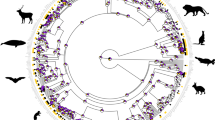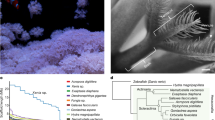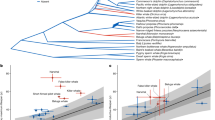Abstract
THE eleven families and nearly one hundred species of ceratioid anglerfish are distributed throughout the world's oceans below a depth of 500 m. The Ceratiidae, with two monotypic genera, Ceratias Kröyer and Cryptopsaras Gill, is one of four ceratioid families whose members exhibit a peculiar and unique mode of reproduction in which dwarfed males become permanently and parasitically attached to the body of a relatively gigantic female. Males of this family have large, forwardly directed eyes, apparently relying entirely on vision for their search and identification of a conspecific female. As in other ceratioid males, they are also equipped with a set of pincher-like denticles at the tips of their jaws for grasping and holding fast to a mate. Attachment is followed by fusion of epidermal tissues, and eventually by a uniting of the circulatory systems, so that the male, whose single function is to produce sperm, becomes dependent on the female for blood-transported nutriment, and the female becomes a kind of self-fertilising hermaphroditic host. Since its discovery 50 years ago, the story of sexual parasitism in ceratioid anglerfish has become a part of everyday scientific knowledge, yet no thoroughly satisfactory analysis of the known facts concerning this remarkable reproductive strategy has been made, in spite of the elegant work of Bertelsen1. This report describes sexual parasitism in surprisingly young females of C. couesi. Contrary to previous thought, it is now evident that parasitic attachment can take place at an extremely early age immediately following metamorphosis.
This is a preview of subscription content, access via your institution
Access options
Subscribe to this journal
Receive 51 print issues and online access
$199.00 per year
only $3.90 per issue
Buy this article
- Purchase on Springer Link
- Instant access to full article PDF
Prices may be subject to local taxes which are calculated during checkout
Similar content being viewed by others
References
Bertelsen, E., Dana Rep., 39, 1–276 (1951).
Regan, C. T., Proc. R. Soc., B 97, 395 (1925).
Bertelsen, E., Dana Rep., 39, 247, 250, 257 (1951).
Fitch, J. E., Bull. So. Calif. Acad. Sci., 72, 164 (1973).
Abe, T., Proc. Japan Acad., 43, 797–800 (1967).
Shoemaker, H. H., Copeia, 1958, 143–145 (1958).
Bertelsen, E., Dana Rep., 39, 138 (1951).
Bertelsen, E., Dana Rep., 39, 144 (1951).
Bertelsen, E., Dana Rep., 39, 206 (1951).
Fitch, J. E., and Lavenberg, R. J., Deep-water Teleostean Fishes of California, 133, 135 (University of California Press, Berkeley and Los Angeles, 1968).
Fitch, J. E., Bull. So. Calif. Acad. Sci., 72, 164 (1973).
Penrith, M. J., J. nat. Hist., 1, 185–188 (1967).
Barbour, T., Proc. New Engl. Zool. Club., 19, 7–14 (1941).
Abe, T., and Nakamura, C., Jap. J. Ichthy., 3, 95–96 (1954).
Fast, T. N., Copeia, 1957, 237–240 (1957).
Author information
Authors and Affiliations
Rights and permissions
About this article
Cite this article
PIETSCH, T. Precocious sexual parasitism in the deep sea ceratioid anglerfish, Cryptopsaras couesi Gill. Nature 256, 38–40 (1975). https://doi.org/10.1038/256038a0
Received:
Accepted:
Issue Date:
DOI: https://doi.org/10.1038/256038a0
This article is cited by
-
Three into one will go
Nature (2009)
-
Dimorphism, parasitism, and sex revisited: modes of reproduction among deep-sea ceratioid anglerfishes (Teleostei: Lophiiformes)
Ichthyological Research (2005)
-
Adaptations of deep sea fishes
Environmental Biology of Fishes (1978)
Comments
By submitting a comment you agree to abide by our Terms and Community Guidelines. If you find something abusive or that does not comply with our terms or guidelines please flag it as inappropriate.



